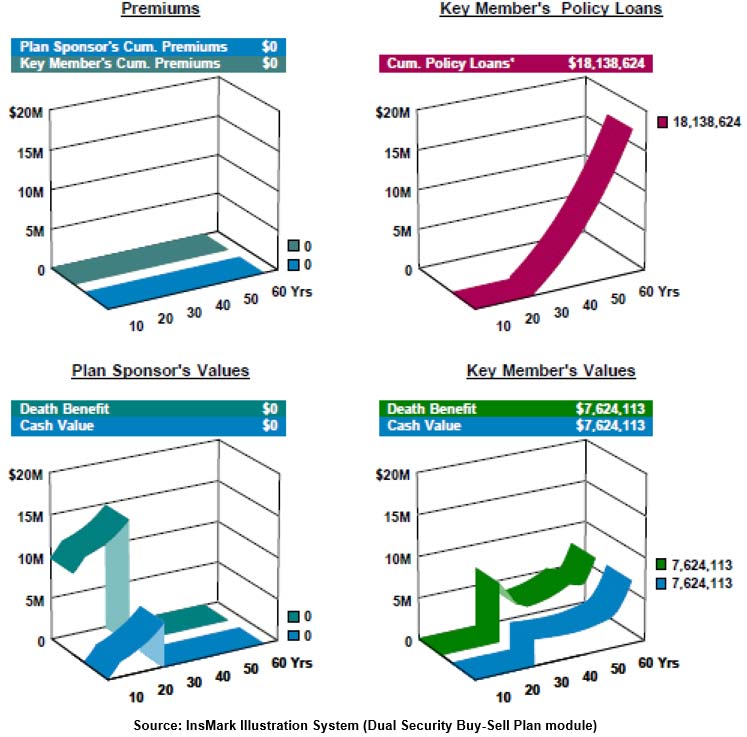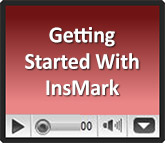(Click here for Blog Archive)
(Click here for Blog Index)
(Presentations in this blog were created using the InsMark® Illustration System)



In Blog #201, I introduced you to InsMark’s Dual Security Buy-Sell Plan. In that Blog, the two sole stockholders of a C corporation fund their Buy-Sell agreement with life insurance owned by a Limited Liability Company (LLC) they formed for that purpose.
In Blog #201, their underlying operating business makes capital contributions directly to the LLC and defines them as bonuses to the stockholder-executives, referred to as “Members” below. The C corporation pays them additional personal compensation that is sufficient to cover the income tax on the transaction (a so-called “gross-up” bonus).
At retirement, each policy is transferred from the LLC to the insured Member on a tax-free basis. (See the Tax Analysis section below for details.) Substantial secured, guaranteed loans on each policy provide $18,000,000 of retirement cash flow for each Member.
Blog #202 provides an alternative funding arrangement using loan regime split-dollar that develops the same buy-sell features and the same tax-free benefits at retirement. It is a little more complicated but seriously more efficient for the C corporation.
At retirement, the LLC repays the debt to the C corporation, typically using policy loans. Each policy then transfers to the insured Member with no income tax consequences to the C corporation, LLC, or Member.
Once the policies transfer, each Member can access tax-free cash flow from the cash value using guaranteed, secured loans totaling more than $18,000,000 for each Member.
Tax Analysis
A well-funded, Buy-Sell arrangement is critical when more than one principal stockholder is present. Using an LLC for this purpose is not a new idea — we have had several such specimen agreements in InsMark’s Cloud-Based Documents On A Disk™ for years, including new ones that apply to the LLC Buy-Sell by stockholders of a C or S corporation. That part of this strategy works as any other Buy-Sell procedure — it creates a market for, and valuation of, the owners’ stock for redemption or cross-purchase purposes (either of which works with LLC-owned life insurance).
The Internal Revenue Code sections governing partnership distributions are different from the ones governing corporations. When a C corporation, for example, distributes a life insurance policy to an employee, the corporation recognizes gain based on its fair market value (which is generally approximated by the policy cash value without regard to any surrender charges) less its premium contributions. The executive receiving the policy also pays income tax on the fair market value.
If an LLC that has elected partnership taxation (as most do) transfers the policy to a Member, the general rule is one of deferral when the distribution involves a K-1 tax form. The receiving Member has no taxable consequences. Although the LLC’s basis in the policy transfers to the Member, the LLC recognizes no taxable gain or loss in the transaction (IRC Secs. 731(a) and 731(b)).
There is no income tax due on the death proceeds of life insurance. The foundation for this particular treatment is IRC Sec. 101(a)(1). This statute provides that the proceeds of life insurance maturing as a death claim are exempt from federal income tax. This exemption applies to the full death benefit, including any cash value component, whether loans exist or not.
Click here for a superb white paper by the Cleveland law firm, Cavitch, Familo & Durkin Co., L.P.A., on the subject of what they refer to as a Life Insurance Limited Liability Company (LILLC) used for funding a Buy-Sell.
Plan Design and Funding
Click here for tips on creating a Dual Security Buy-Sell Plan.
There are several ways to fund a Dual Security Buy-Sell Plan:
- Funding Strategy #1: Funds already present in the LLC.
- Funding Strategy #2: The Members make capital contributions or loans to the LLC.
- Funding Strategy #3: The Members’ underlying operating business makes capital contributions directly to the LLC and defines them as follows:
- ✓ C corporation: Capital contributions are a taxable bonus to the LLC Members. (Blog #201 featured this payment strategy.)
- ✓ S corporation: Capital contributions are taxable allocations of profits.
- Funding Strategy #4 (used in this Blog): The Members use loan-regime split-dollar to fund the policies. The long-term Applicable Federal Rate is imputed to the Members personally. Their underlying operating company (a C corporation) provides each Member with a personal gross-up bonus that covers the income tax on the imputed income plus the income tax on the bonus1. Consequently, the out-of-pocket cost for the Members is $0.
Split-dollar loans to the LLC cover all five of the premiums on each policy. A policy loan at the beginning of year 21 repays the premium loans to the C corporation. The corporation’s only non-recoverable costs are the after-tax cost of the bonuses paid to the Members.
1 When using a bonus to assist with the payment of tax on imputed loan interest, care must be taken not to have the executive use these bonus payments to make loan interest payments (or loan repayments) back to the employer. This restriction complies with the prohibition against the employer making such payments as provided in the split-dollar final regulations issued in 2003 (TD 9092, 9/11/03 and Rev. Rul. 2003-105). Bonuses used to offset the income tax on imputed income are not prohibited. - Funding Strategy #5: The LLC arranges for bank-funded, premium financing with the Members guaranteeing the bank loan and providing any additional collateral required by the bank. (I indicated in Blog #201 that I would feature Strategy #5 in Blog #202. Loan regime split-dollar turned out to be so impressive that I decided to use it for Blog #202.)
- Funding Strategy #6: The Members combine bank-funded, premium financing with a loan-regime split-dollar arrangement.
Illustration software published by InsMark, Inc., can demonstrate each of the funding strategies listed above.
Case Study
Harry Stafford, CEO, and Oliver Belmont, President, both age 45, are 50/50 stockholders and senior executives of SB Chemical Company, Inc. (SBCC), a C corporation with a combined federal and state income tax rate of 28.00%. Harry and Oliver have been reviewing their current Buy-Sell arrangement completed a few years ago. They have decided to update it using a Dual Security Buy-Sell Plan that is more appropriate due to its double-barreled tax benefits.
They have formed Stafford & Belmont, LLC, solely to finance the Buy-Sell transaction. SBCC, their underlying operating company, makes loans directly to the LLC and defines them as funding for a loan regime split-dollar arrangement secured by the values of the life insurance policy. Harry and Oliver, as the sole LLC Members, are responsible for any shortfall of the loans as well as taxes due to the imputed loan interest.
Click here for a Flow Chart of the Loan-Based Split-Dollar transaction that funds the Buy-Sell.
Click here for a Flow Chart of the Dual Security Buy-Sell transaction including the split-dollar data.
Below are the details of each life insurance policy:
- Each insured is a Male, age 45.
- Policy type: Indexed Universal Life illustrated at 6.50%.
- Face amount of each policy: $9,500,000.
(Increasing for 20 years, level after that.) - Premiums for each policy: $400,000 for five years.
Pre-Retirement Years
Allocation of each $9,500,000 increasing death benefit:
- $8,000,000, plus all of the policy’s increasing death benefit, is payable to the LLC for 20 years to fund the Buy-Sell agreement (reflecting growth of the C corporation’s stock for each participant).
- $1,500,000 of a level death benefit is payable to the LLC for 20 years and dedicated to Key Member indemnification. If a death claim occurs, the proceeds can be distributed tax-free to the surviving Member via a K-1. That Member can, if desired, use the proceeds for a capital contribution to the underlying C corporation if funds are needed to offset the loss of the deceased participant.
Retirement Starting at Age 65
(after the transfer of the policy)
- Each insured owns all the policy cash values after repayment of the split-dollar loans to SBCC.
- Each Member receives all tax-free cash flow from the policy using secured, non-callable loans. (Annual cash flow from age 65 to 100 is illustrated at $300,000 indexed with a 3.00% cost-of-living assumption, providing total after-tax cash flow of $18,138,624 for each Member.)
- Policy death benefits are paid to each insured’s personal beneficiaries.
Below is a graphic of Harry Stafford’s and Oliver Belmont’s results from their Dual Security Buy-Sell Plan sponsored by Stafford & Belmont, LLC:
| Image 1 |
| Dual Security Buy-Sell Plan |
| Plan Sponsor: Stafford & Belmont, LLC |
| Both Harry and Oliver are the Same Age; |
| Results Below Apply to Each of Them. |

Below is a Composite of Harry and Oliver’s benefits from their Dual Security Buy-Sell Plan:
| Image 2 |

Click here to review Harry’s and Oliver’s loan regime split-dollar illustrations. Note in Col. (4) on Harry’s Page 8 and Oliver’s Page 25 that the C corporation’s total charge to earnings for providing this massive benefits is $254,476 for each of them. This extraordinarily low cost relative to benefits2 is why I chose loan regime split-dollar over premium financing.
| 2 | $18,138,624 of after-tax, retirement cash flow plus long-range residual cash value of $7,624,113 for each of them — all wrapped up in millions of death benefit. |
Click here to view the Composite of Harry’s and Oliver’s Dual Security Buy-Sell Plan including the loan regime split-dollar data (that was exported to the Dual Security Buy-Sell).
Click here for instructions on exporting data from InsMark’s Loan-Based Split-Dollar System into a Dual Security Buy-Sell Plan module in the InsMark Illustration System.
Source of Illustrations
The Dual Security Buy-Sell Plan (DSBS) illustration module is available on the Executive Benefits tab in the InsMark Illustration System. It can include values exported from LB-SD. Also included in the DSBS illustration module is a Composite for multiple lives.
You can illustrate variations of loan regime split-dollar using InsMark’s Loan-Based Split-Dollar System (LB-SD), including Loan-Based Private Split-Dollar.
Conclusion
Most of you have access to C and S corporations with multiple owners who will jump at the chance to take advantage of this Buy-Sell strategy and its powerful, after-tax, retirement cash flow and residual cash value.
Your Comments
What are your thoughts and conclusions after reviewing this material? Please add your comments to this Blog. Your email address will not be published.
Licensing InsMark Systems
To license the InsMark Illustration System and/or Loan-Based Split Dollar System, visit us online or contact Julie Nayeri at julien@insmark.com or 888-InsMark (467-6275).
Institutional inquiries should be directed to David Grant, Senior Vice President – Sales, at dag@insmark.com or (925) 543-0513.
Discounted Upgrades
If you are currently licensed for the InsMark Illustration System (IIS), you can add the Loan-Based Split-Dollar System (LB-SD) to it. We are offering producers an exceptional opportunity to upgrade by adding the LB-SD component to an Advanced version of IIS for just $519 plus $45 monthly (the retail price of LB-SD is $1,299 plus $69 monthly).
The Advanced version of IIS includes the Dual Security Buy-Sell modules plus Loan-Based Split Dollar (both executive benefit and trust-owned variations).
If you currently aren’t licensed for either System, you can have access to Advanced IIS. We are offering it for a significantly discounted licensing fee of $1,699 plus $90 monthly (the unbundled retail price for both Systems is $2,298 and $114 monthly).
These licensing fees reflect super-significant discounts, which will expire on July 31, 2020. Contact Julie Nayeri at julien@insmark.com or 888-InsMark (467-6275) today for your licensing needs!
There is also special pricing for our institutional clients — contact David Grant, Senior Vice President – Sales, at dag@insmark.com or (925) 543-0513.
InsMark Power Producers:
InsMark’s Platinum-level Power Producers currently have all our Systems (including both the InsMark Illustration System and the Loan-Based Split-Dollar System.)
We have special pricing for Gold-Level and Silver-Level Power Producers to upgrade their InsMark Illustration System to include the Loan-Based Split-Dollar System. Contact Julie Nayeri at julien@insmark.com or 888-InsMark (467-6275) for details.
Specimen Documents
 InsMark’s Cloud-Based Documents On A Disk™ (“DOD”) has specimen implementation documents for the Dual Security Buy-Sell Plan in both the Buy-Sell Agreements section and Business Owner Benefit Plans section (see the Limited Liability Company documents in each section). These specimen implementation documents are for licensees to study or provide to a client’s attorney.
InsMark’s Cloud-Based Documents On A Disk™ (“DOD”) has specimen implementation documents for the Dual Security Buy-Sell Plan in both the Buy-Sell Agreements section and Business Owner Benefit Plans section (see the Limited Liability Company documents in each section). These specimen implementation documents are for licensees to study or provide to a client’s attorney.
If you are currently licensed for DOD, click here for access. (Once you login, click on the DOD icon.)
If you are not licensed for DOD, but would like to learn more about it, click here or contact Julie Nayeri at julien@insmark.com or 888-InsMark (467-6275).
Institutional inquiries — contact David Grant, Senior Vice President – Sales, at dag@insmark.com or (925) 543-0513.
Creating Similar Dual Security Plan Presentations
If you would like some help creating customized versions of the presentations in this Blog for your clients, watch the video below on how to download and use InsMark’s Digital Workbook Files.
If you would like highly qualified, illustration design assistance with no commission split required, contact LifePro Financial, InsMark’s Referral Resource, discussed below.
Digital Workbook files: For those licensed for the InsMark Illustration System and/or InsMark’s Loan-Based Split-Dollar System, click the link below:
|
Before downloading and reviewing any files, be certain you have installed the most current updates to your InsMark System(s). Do this using Live Update available under Help on the main menu bar of the System or this icon on the main menu bar:
Note: If you are viewing this on a cell phone or tablet, the downloaded Workbook file won’t launch in your InsMark Systems. Please forward the Workbook where you can launch it on your PC where your InsMark System(s) are installed. |
If you download the Digital Workbook File for Blog #202, click here for a Guide to its content. It will be invaluable to you as you design similar illustrations.
InsMark’s Referral Resources
(Put our Illustration Experts to Work for Your Practice)
We created Referral Resources to deliver a “do-it-for-me” illustration service in a way that makes sense for your practice. You can utilize your choice of insurance company, there is no commission split, and you don’t have to change any current relationships. They are very familiar with running InsMark software.
Please mention my name when you talk to a Referral Resource as they have promised to take special care of my readers. My only request is this: if a Referral Resource helps you get the sale, place at least that case through them; otherwise, you will be taking unfair advantage of their generous offer to InsMark licensees.
Save time and get results with any InsMark illustration. Contact:
- Ben Nevejans, President of LifePro Financial Services in San Diego, CA.

Testimonials
“InsMark has created without question the best suite of software for our industry that has ever existed. I personally have been using their software for almost 30 years, and it changed my career. This unique and user friendly software will add many thousands to your income for as long as you’re in business. InsMark makes me look good, and it will you as well.”
Simon Singer, CFP®, CAP®, RFC®, Past President International Forum, InsMark Platinum Power Producer®, Encino, CA
“The InsMark software is indispensable to my entire planning process because it enables me to show my clients that inaction has a price tag. I can’t afford to go without it!”
David McKnight, Author of The Power of Zero, InsMark Gold Power Producer®, Grafton, WI
“InsMark’s referral resource, Brian Manderscheid from LifePro, has been a gem to work with! He helps us use InsMark with every one of our cases. The genius factor is InsMark’s commitment to “Compared to What.”
Glenn Main, InsMark Platinum Power Producer®, McMurray, PA
“The reason I use InsMark products is because they are so good at explaining financial concepts to all three parties: 1) the producer trying to explain the idea; 2) the computer technician trying to illustrate it; 3) the customer trying to understand it.”
Rich Linsday, CLU, AEP, ChFC, InsMark Power Producer®, Top of the Table, International Forum, Pasadena, CA
“I really thought I knew all the sales techniques that affect my business, but I do now, thanks to InsMark.”
Sam Keck, MBA, CLU, CFP, LUTCF, InsMark Platinum Power Producer®, Financial Planner, Denver, CO
“InsMark is the Picasso of the financial services world — their marketing savvy never fails to amaze me.”
Doug Peete, Past President, Top of the Table, and InsMark Power Producer, Overland Park, KS

“InsMark” is registered trademark of InsMark, Inc.
“Documents On A Disk” is a trademark of InsMark, Inc.
Copyright © 2020 InsMark, Inc.
All Rights Reserved

Important Note #1: The hypothetical values associated with this Blog assume the nonguaranteed values shown continue in all years. This is not likely, and actual results may be more or less favorable. Life insurance illustrations are not valid unless accompanied by a basic illustration from the issuing life insurance company.
Important Note #2: The information in this Blog is for educational purposes only. In all cases, the approval of a client’s legal and tax advisers must be secured regarding the implementation or modification of any planning technique as well as the applicability and consequences of new cases, rulings, or legislation upon existing or impending plans.
Important Note #3: There is a potential tax bomb in life insurance that can accidentally be triggered by a careless policyowner. This unfortunate development occurs when policy loans are present, and net cash values are so low that the income tax on the gain on surrender can be significantly more than the net cash surrender value.
This lurking tax bomb can be present in all forms of cash value life insurance containing policy loans of any type. Be sure your clients are aware of how to sidestep it.
The tax bomb can be avoided if the policy is neither surrendered nor allowed to lapse since the policy death benefit wipes away the income tax liability. The foundation of this particular tax treatment involves IRC Section 101. This statute provides that the proceeds of life insurance maturing as a death claim are exempt from federal income tax. This exemption applies to the full death benefit, including any cash value component, whether or not loans exist.
Note: It is best to design the policy with no premiums scheduled after retirement if loans may occur in retirement years. This design may require higher premiums during pre-retirement years, but a policy with no premiums scheduled is much more tolerable at advanced ages than one with continuous premiums.
Can your clients remember these facts years into the future? If they are incapacitated, will family members understand the issues? It is probably best to file a short note with the policy – something like this (although your compliance officer will likely have preferred language):
If/when you take policy loans on this policy, be sure to talk to your financial adviser before surrendering or lapsing the policy to anticipate unexpected tax consequences that may otherwise be avoided.
Does this note make it harder or easier to deliver the policy? It’s harder if you haven’t discussed it with your client, and that’s the point – you should discuss it.
Some life insurance companies have concierge units that monitor loan status at the point of lapse or surrender. You would be well-advised to select an insurance company with this capacity as carriers need to be proactive in their client relationships, not merely reactive to client inquiries. I hope that the policyholder service division of all life insurance companies will ultimately bring this potential liability to those surrendering or lapsing policies, particularly those with 50% or more of the gross cash value subject to outstanding loans.
![]()
More Recent Blogs:
Blog #201: Awesome LLC Buy-Sell Strategy for Owners of C and S Corporations (Part 1)
Blog #200: InsMark’s Prudent Care™ Analysis (Part 2)
Blog #199: InsMark’s Prudent Care™ Analysis (Part 1)
Blog #198 How Far Will $1,000,000 Go (Part 2) Joe and Annie Jordan’s Comprehensive Retirement Plan
Blog #197: How Far Does $1,000,000 Go (Part 1)
| 3 Reasons Why It’s Profitable For You To Share These |
| Blog Posts With Your Business Associates and |
| Professional Study Groups (i.e. “LinkedIn”) |
Robert B. Ritter, Jr. Blog Archive





